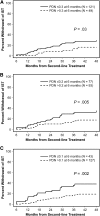Failure-free survival after second-line systemic treatment of chronic graft-versus-host disease
- PMID: 23321253
- PMCID: PMC3606068
- DOI: 10.1182/blood-2012-11-465583
Failure-free survival after second-line systemic treatment of chronic graft-versus-host disease
Abstract
This study attempted to characterize causes of treatment failure, identify associated prognostic factors, and develop shorter-term end points for trials testing investigational products or regimens for second-line systemic treatment of chronic graft-versus-host disease (GVHD). The study cohort (312 patients) received second-line systemic treatment of chronic GVHD. The primary end point was failure-free survival (FFS) defined by the absence of third-line treatment, nonrelapse mortality, and recurrent malignancy during second-line treatment. Treatment change was the major cause of treatment failure. FFS was 56% at 6 months after second-line treatment. Lower steroid doses at 6 months correlated with subsequent withdrawal of immunosuppressive treatment. Multivariate analysis showed that high-risk disease at transplantation, lower gastrointestinal involvement at second-line treatment, and severe NIH global score at second-line treatment were associated with increased risks of treatment failure. These three factors were used to define risk groups, and success rates at 6 months were calculated for each risk group either without or with various steroid dose limits at 6 months as an additional criterion of success. These success rates could be used as the basis for a clinically relevant and efficient shorter-term end point in clinical studies that evaluate agents for second-line systemic treatment of chronic GVHD.
Figures



Comment in
-
Order out of chaos.Blood. 2013 Mar 21;121(12):2170-2. doi: 10.1182/blood-2013-01-480491. Blood. 2013. PMID: 23520329 No abstract available.
References
-
- Wolff D, Schleuning M, von Harsdorf S, et al. Consensus Conference on Clinical Practice in Chronic GVHD: Second-Line Treatment of Chronic Graft-versus-Host Disease. Biol Blood Marrow Transplant. 2011;17(1):1–17. - PubMed
-
- Lee SJ, Vogelsang G, Gilman A, et al. A survey of diagnosis, management, and grading of chronic GVHD. Biol Blood Marrow Transplant. 2002;8(1):32–39. - PubMed
-
- Lee SJ, Joffe S, Artz AS, et al. Individual physician practice variation in hematopoietic cell transplantation. J Clin Oncol. 2008;26(13):2162–2170. - PubMed
-
- Martin PJ, Weisdorf D, Przepiorka D, et al. Design of Clinical Trials Working Group. National Institutes of Health Consensus Development Project on Criteria for Clinical Trials in Chronic Graft-versus-Host Disease: VI. Design of Clinical Trials Working Group report. Biol Blood Marrow Transplant. 2006;12(5):491–505. - PubMed
Publication types
MeSH terms
Substances
Grants and funding
LinkOut - more resources
Full Text Sources
Other Literature Sources

